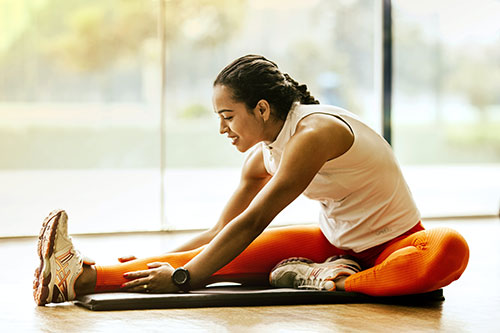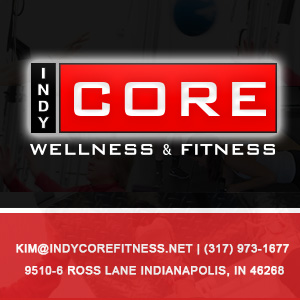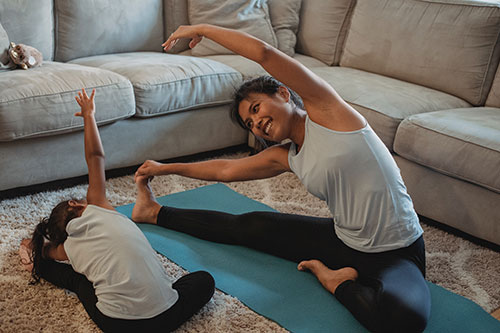Check out our latest video regarding the basics of static stretching and the importance of a thorough warm-up.
All posts by Coredtofit
Foam Rolling 101
By: Megan Lambert
If you enjoy reading this blog, check out our new YouTube page! This page will provide visual content to correlate with the written content posted on this blog. Check out the following video explaining self-myofascial release and how incorporate it into your recovery methodology.
5 Reasons to Exercise Before your Joint Replacement
By: Megan Lambert
Approximately one million hip and knee replacements are completed by surgeons every year, according to the Mayo Clinic website.
Although joint replacements are major surgeries, there are ways to prepare your body for these operations. For example, here at Indy Core Wellness & Fitness, we write specific exercise protocols to prepare clients for their replacement. These exercises are designed to improve muscle strength and stamina.
In addition to gaining strength, here are five major reasons you should exercise before going under the knife:
- You decrease the risk of post-surgery complications
The Wall Street Journal article entitled, “Are you Fit for Surgery?,” speaks to this idea. The thought is that when patients resolve chronic issues such as obesity, diabetes, and smoking, they are physically healthier going into surgery. So, they are less likely to have complications after the operation.
- You are less likely to need post-surgery inpatient rehab
A 2006 research study by Daniel Rooks of Beth Israel Deaconess Medical Center showed that patients who exercised six weeks prior to surgery were 73 percent less likely to need inpatient rehab after the surgery.
- You will save money
Less post-surgery rehab equals less money spent. Yay!
- You decrease your risk of post-surgery injury
After a hip or knee replacement, you will need to use more of your upper body strength to transfer yourself from one place to another. By strengthening the muscles of your upper body, you decrease the risk of falling while transporting yourself. Consequently, you also reduce the risk of injuring yourself while rehabbing from another injury.
- You better tolerate the surgical anesthetic
Cardiovascular training, which can include exercises such as walking, biking, rowing, using the elliptical, etc. strengthens your heart and lungs. Healthier essential organs help your body better tolerate the rigors of surgery such as the anesthetic.
Voodoo Flossing: the contemporary approach to injury
By: Megan Lambert
What is voodoo flossing?
Contrary to your first impression, voodoo flossing is a modern method of injury rehabilitation, workout recovery, and joint mobilization, not a medieval torture device.
In essence, it is an extreme form of compression. Pressure is applied to an area of the body using a thin, stretchy band like the one shown below.

Once, lets say, your ankle is wrapped with the voodoo wrap, all you have to do is perform normal movement patterns. For example, one would walk forwards and backwards, do body weight squats and calf raises, while wearing the wrap.
After leaving the band on for up to two minutes, the band is removed and normal blood flow is restored to the area.
This modality is useful for athletes recovering from workouts, individuals rehabbing tendon or ligament injuries, and anyone striving to attain greater joint mobility.
Why do you use flossing?
It’s no secret that your body’s tendons and ligaments have a smaller blood supply than your muscles. These connective tissues receive less oxygen and nutrients from the blood, so when injury occurs, it takes longer for the tissues to heal. One way to help these tissues heal faster is by increasing the blood flow to the area. Enter voodoo flossing.
Wrapping the flossing band around the injured area limits the amount of blood that can enter the area. When the wrap is removed, the blood rushes back into that area of the body. Not only does this bring a greater amount of blood to the area than before, but it also brings with it more oxygen and nutrients.
How does Indy Core use flossing?
Recently, we used flossing to alleviate peroneal tendon pain for one of our clients. At the risk of sounding like a boring anatomy professor, this tendon is located on the lateral side of the leg and runs from the head of the fibula, down the leg and inserts near the base of the big toe. After examining his leg, we discovered that the source of the pain was in the peroneal and calf muscles, not behind in his ankle where he felt the most discomfort.
Consequently, we wrapped the band around his upper calf (like the picture below) where we felt the most scar tissue and tissue adhesion.

After approximately two minutes of walking backwards and forwards and doing squats and stretches, the client took the band off and felt relief from the pain. This is just one example of how we utilize this modality in our practice every day.
Thank you for reading and stay tuned for a video detailing more about flossing.
For more information about how you can utilize flossing in your workouts, call Indy Core at (317) 430-0063.
How Crucial is that Post-Workout Snack?
By: Megan Lambert
Apples and almond butter, protein bars, and green smoothies are a just a few examples of snack options that fitness enthusiasts enjoy after workouts.
However, author and fitness expert, Ben Greenfield, argues that eating a snack or a meal after training is not actually necessary. Below is an excerpt from chapter 16 of his book entitled “Beyond Training.” In this passage, Greenfield explains why eating a post-workout snack is not as critical as you might think.
“You’ve probably heard about a magical fueling window. From exercise physiology books to magazine articles to websites, nearly every resources on sports nutrition says that after you finish a workout, you have twenty to sixty minutes to replace previous energy by consuming a mix of carbohydrates and proteins.
Here’s what they don’t say:
In every study or experiment that has investigated the benefits of immediate post-workout nutrition replacements, subjects were fed after completing an exercise session that they had performed in a fasted or semistarved state.
Of course you’re going to recovery more quickly if you eat a meal after a workout in which you were completely depleted of energy and 100 percent fasted. But how many of us actually roll out of bed in the morning, hope on a bike, and ride hard for ninety minutes to two hours with absolutely no fuel?
So, here’s the deal: If you’ve had a preworkout meal, or had a meal in the not-too-distant past, there’s no do-or-die need to eat after your workout – especially if you’re still burping up that meal you ate before exercising. This is especially true if you have no other workouts planned for the day, because your body can completely replenish energy levels within just eight hours of normal hunger-driven, real-food eating…
But it does make sense to refuel within that twenty- to sixty-minute window if:
- You didn’t eat anything before your workout and you’re in a totally energy-depleted state (such as from a hard session before breakfast).
- You are going to work out again within the next eight hours.
- You’re trying to pack on muscle as fast as possible (aka eat every piece of real food in sight and lift heavy stuff).”
5 Stretches to do while Watching TV
By: Megan Lambert
Everyone knows that improving muscle flexibility enhances joint function, muscle stiffness, and overall mobility.
But, let’s be real. Who actually takes the time to stretch every day?
That’s why we are presenting five simple stretches to do while watching your favorite prime-time TV show. First, perform a few exercises to get your blood flowing to the muscles you are going to stretch. For example, you could do 10 jumping jacks, 10 air squats, and 10 push-ups to warm up your upper and lower body. Then, hold each of the following stretches for at least 30 seconds. Over time, your flexibility and mobility will increase!
- Couch stretch
Bend one leg and place your foot behind you on the couch. Then, take the other leg and place it in front of the body at a 90 degree angle. You should feel the stretch on the front of your hip and thigh. To make the stretch more pronounced, squeeze your glutes.

2. Hamstring stretch
Sit on the floor with one leg bent towards the body and one leg straight out in front of you. Reach toward your toes with both of your hands. Keep reaching until you feel a stretch in the back of your thigh.

3. Back stretch
Kneel on the floor with your arms straight out in front of you. Sit your hips back to your heels to feel the stretch in the large muscles of your back. Slowly reach your hands to one side, feeling a more pronounced stretch on one side of the body and then repeat for the other side.

4. Cat/cow stretch
Kneel on your hands and knees on the ground. For this stretch, slowly arch your back and then round your back to feel a stretch throughout the muscles around your spine. Continue these two movements for at least 30 seconds


5. Chest stretch
Place your forearm on a wall or door frame at a 90 degree angle. Rotate your lower body away from the wall so that you feel a stretch across your chest and the front of your shoulder. Move your forearm up or down the wall to stretch the different areas of the muscle.

How to Stand against the Sitting Problem
By: Megan Lambert
Have you ever heard the saying, “Sitting is the new smoking?”
Dr. James Levine, a Mayo Clinic specialist, coined this phrase to illustrate how sitting negatively affects the body.
But, do you really have a choice in the matter? I mean, you sit when you drive, you sit when you eat, you sit when you study, you sit in your workplace, etc.
Dr. Kelly Starrett, successful physical therapist, owner of San Francisco Cross Fit, and founder of the Mobility Project, has made it his mission to give people a solution to this problem.
Watch the video below and learn how switching to a standing desk in your workplace environment can impact your daily productivity and increase your business’ success. If you would like to watch the entire interview, visit https://www.creativelive.com and search for the “30 Days of Genius” video series.
Foam Rolling: the inexpensive way to train like an Olympian
By: Megan Lambert
Simone Biles, Usain Bolt, and Michael Phelps have one thing in common.
Well, besides the fact that each of these athletes won gold medals in their respective events at the Olympics this summer. In training for the Olympics Biles, Bolt, and Phelps spent copious amounts of hours in the gym, on the track, and in the pool. However, each of these athletes also spent time utilizing techniques to help their bodies recover from workouts.
But, an Olympian is not the only person who needs to properly recover after an exercise session. The high school athlete, successful business person, and average weekend gym warrior do as well.
Have you ever completed a workout and then woken up the next morning feeling like your muscles are screaming at you? Muscle soreness cannot be completely prevented; however, there are ways to reduce the symptoms.
One inexpensive method is to use a foam roller.

Foam rolling, also called self-myofascial release, is a process where you apply pressure to the muscle via a foam roller. Applying pressure where the muscle is sore, as well as above and below the affected area, causes scar tissue to be broken up, which allows the muscle fibers to heal correctly.
Foam rolling immediately after exercise, as well as the day after a workout, reduces muscle soreness.
To learn more about foam rolling techniques, watch the video below, which was created by health and fitness expert, Ben Greenfield.
Welcome to Indy Core Fitness

Welcome to the Indy Core Fitness Blog, dedicated to people of all ages who are passionate about health and physical fitness. In this blog, professionals will provide readers with recommendations about strength training, recovery techniques, injury prevention, and healthy wellness habits.
So, what is Indy Core Fitness?
We are a privately owned fitness facility located on the northwest side of Indianapolis. We offer personal training sessions focused on the different needs of each client. Our workout programs focus on functional training, which means we train in a way that is relevant to the activities in our clients’ daily lives.
Again, welcome to the Indy Core Fitness Blog. Please “like” us on Facebook and follow us on Twitter to receive new blog post updates. To learn more about the services we offer at Indy Core Fitness, call (317) 973-1677 to schedule an appointment today.




